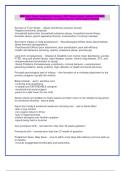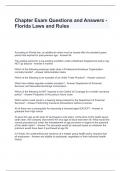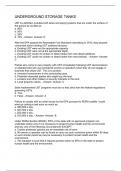HBD Final Exam | Questions & Answers (100 %Score) Latest Updated 2024/2025
Comprehensive Questions A+ Graded Answers | With Expert Solutions
Sources of Toxic Stress - -Abuse (emotional, physical, sexual)
-Neglect (emotional, physical)
-Household dysfunction (household substance abuse, household mental illness,
domestic abuse, parent separation/divorce, incarceration of a family member)
Short-term impact on child development - -Neurobiological effects (brain abnormalities,
stress hormone dysregulation)
-Psychosocial Effects (poor attachment, poor socialization, poor self-efficacy)
-Health risk behaviors (smoking, obesity, substance abuse, promiscuity)
Long-term consequences - -Disease & Disability (can involve major depression, suicide,
PTSD, drug and alcohol abuse, heart disease, cancer, chronic lung disease, STD, and
intergenerational transmission of abuse)
-Social Problems (homelessness, prostitution, criminal behavior, unemployment,
parenting problems, family violence, high utilization of health and social services)
Principal psychological task of infancy - =the formation of an intimate attachment to the
primary caregiver (usually the mother)
Baby's Needs - -warm, sensitive care
-nurturing and consistency
-a steady and DEPENDABLE caregiver
-emotional and social support
-parent is a safe haven for the child
Allows infants and toddlers to freely explore and then return to the reliably loving person
for emotional refueling - secure base
Signs that a baby's emotional needs are not being met - -sad or bland affect
-lack of eye contact
-non-organic failure to thrive
-lack of responsiveness
-prefers strangers over familiar caregiver
-rejects being held or touched
Very premature birth - neonate born less than 32 weeks gestation
Premature birth - neonate born less than 37 weeks of gestation
Postpartum blues; baby blues - -occurs within a few days after delivery and can lasts up
to 2weeks
-involves exaggerated emotionality and tearfulness
, -characterized by good grooming and continued interaction with friends and family
Major Depressive Disorder - -occurs within 4 weeks after delivery and can last up to 1
year without treatment (but about 3-6 weeks with treatment)
-involves feelings of hopelessness and helplessness + a lack of pleasure or invest in
activities
-characterized by poor self-care
-can include psychotic symptoms such as hallucinations and delusions
-the mother MAY harm the infant
Brief psychotic disorder (postpartum onset) - -occurs within 4 weeks after delivery and
can last up to 1 month
-involves psychotic symptoms which are NOT accounted for by major depressive
disorder with psychotic features
-the mother MAY harm the infant
Secure Attachment - -the child openly protests to the parent's departure and exhibits
separation anxiety
-when the parent returns, they will greet and/or approach the parent and then return to
play
Secure Attachment Child - "the world is safe, I am effective at getting my needs met.
mom is there when I need her"
Anxious/Avoidant - -the child appears unmoved by parent's absence or return - they are
more heavily engaged with the environment
Anxious/Avoidant Child - "the world is dangerous. relationships can't help, I have to
manage on my own"
Anxious/Resistant - -the child is upset throughout, is difficult to soothe, may be angry,
does not return to play
Anxious/Resistant Child - "the world is dangerous, I can't cope alone, i must keep mom
focused on me"
Disorganized/Disoriented - -the child expresses mixed emotions; engaging in confusing
behaviors, freezing, falling, contradictory strategies
Disorganized/Disoriented Child - "the world is very dangerous. I don't know what to do.
nothing i try makes me feel safer"
Reactive attachment disorder - in children, a pattern of inhibited, withdrawn behavior
toward adult caregivers - unresponsive







